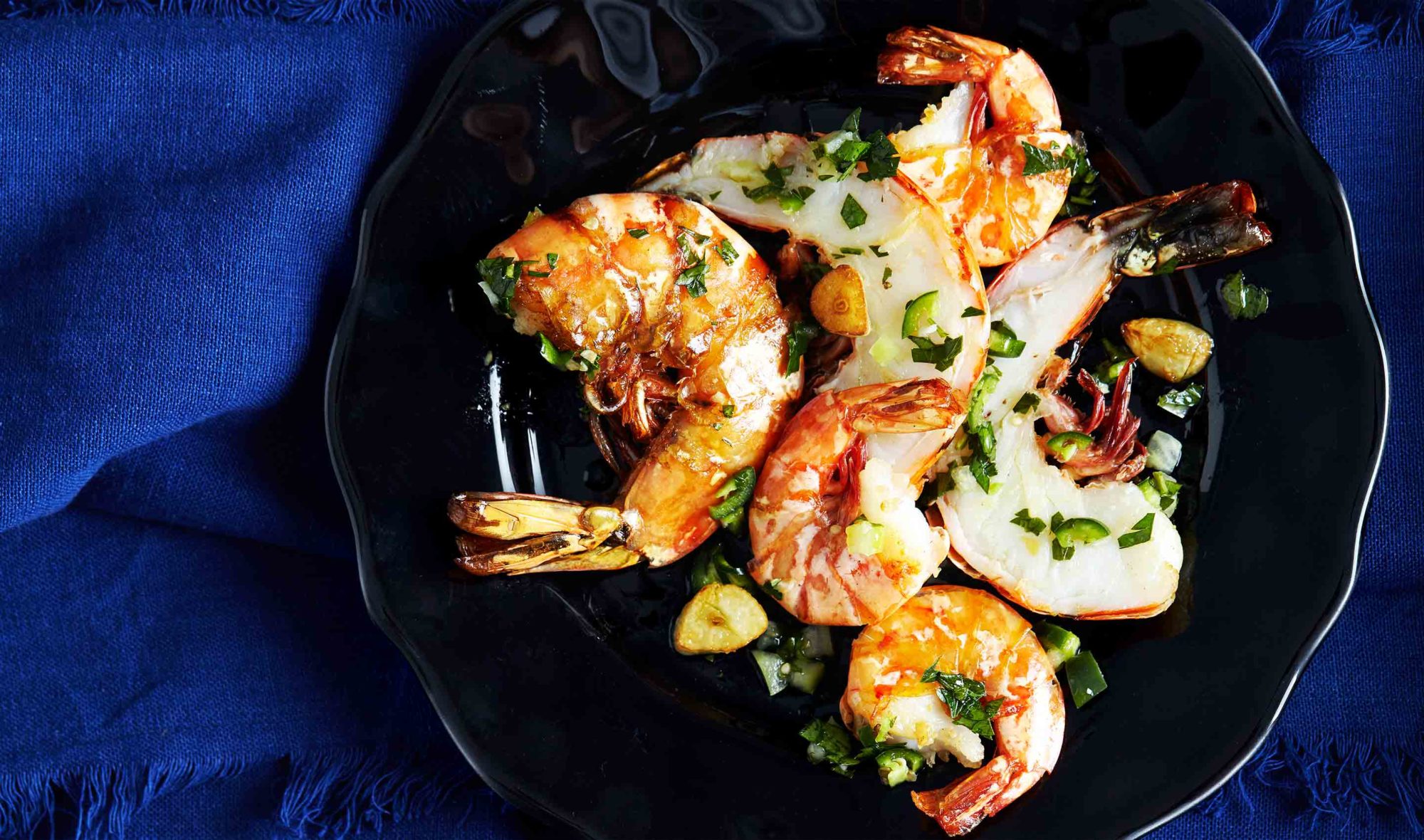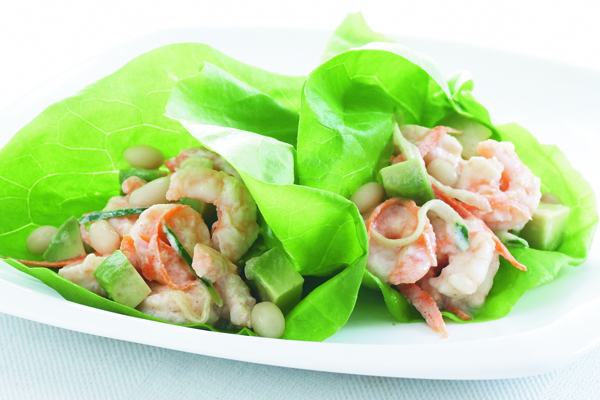
Join PN Level 2 for less than $9 USD/day! Affordable monthly payments now open.

Shrimp are small, swimming crustaceans that can be found near the seafloor. They offer a flavorful, tender meat inside their shells. Shrimp are a good source of protein, as well as vitamin D, B12, and B3, though they are also relatively high in cholesterol. Shrimp cook quickly: as soon as they change from translucent-blue to opaque-pink they are cooked. They can be poached and eaten with cocktail sauce, grilled and dunked in clarified butter, or enjoyed as part of your favorite seafood recipe.
Shrimp are small, swimming crustaceans that can be found near the seafloor of most coasts and estuaries, and sometimes in lakes and rivers.
Shrimp are numerous in species. Tiger shrimp and White shrimp are two common varieties. They are typically available frozen year-round.
Note: Sometimes shrimp are referred to as prawns. This is the common term for shrimp in the UK.
Shrimp have long, narrow abdomens and long antennae; they look somewhat like small lobsters. They have a thin but hard outer shell, which should be removed before eating.
Raw, shrimp have a blue, translucent hue. Once cooked, they turn opaque and pink.
Shrimp range in size: the smallest are about as big as a thumbnail while colossal shrimp may be as big as your palm.
Three ounces of raw shrimp contains approximately 72 calories, 18.0g of protein, 0.0g of carbohydrates, 0.0g of fibre, and 0.5g of fat.
Shrimp does contain some cholesterol: approximately 137mg per three ounces of shrimp.
Shrimp can typically be purchased frozen, in bags. There are usually several options when picking shrimp: First, decide if you want to buy them raw or cooked. Next, you will need to select whether you prefer whole, shelled, or “EZ Peel.” The latter option means the heads have been removed, the meat and shell have been slit down the back, and sometimes the black ‘vein’ running through the shrimp has been removed.
Finally, consider the size of the shrimp. Sizes range from tiny to colossal. Check the bag for the number of shrimp it contains per pound: usually, the lower the number of shrimp per pound, the bigger the shrimp.
Avoid buying “fresh” shrimp from the grocery counter – it is usually defrosted shrimp and not as fresh as the frozen kind.
Keep frozen shrimp in the freezer. You can defrost the shrimp overnight in the fridge, or take it out of the freezer shortly before cooking if using a ‘quick defrost’ method (see below).
Thaw shrimp overnight in the freezer or defrost quickly by putting shrimp in a colander and sitting under cold running water for about 15 minutes.
If the shrimp are whole, pull off the head first. Then, pull off the legs. For “EZ Peel” shrimp, the legs and shell should pull off in one smooth motion.
If removing the tail, squeeze the tail at its base, close to where it meets the end of the shrimp. This will help you avoid losing any extra tail meat.
De-veining is a final step. If this has not been done already, take a pair of tweezers or a paring knife and pull out the thin, black thread (it is actually an intestine) that runs through the shrimp. The ‘vein’ is edible but not aesthetically appealing.
Once your shrimp are ready to be cooked, you have many options. Here are two:
Grilled shrimp: Defrost unpeeled shrimp, dry well with paper towels and sprinkle with 1tsp salt. Meanwhile, heat a gas grill to medium-high. Using long-handed tongs, arrange the shrimp on the grill grates, positioning them so they don’t fall through the cracks. Close the grill but don’t go far: the shrimp will cook quickly. After they have been cooking for 2-3 minutes, turn the shrimp and cook for another 2-3 minutes. The shrimp are cooked when they are no longer opaque, and the flesh is starting to curl. Serve with melted butter or ghee, or cocktail sauce.
Poached shrimp: Defrost shrimp but leave them peeled. Bring 3 cups of water to a boil. If you wish, you can flavour the water with peppercorns, bay leaves, and sliced lemon. You can also substitute up to 2 cups of the water with white wine. Once the liquid is boiling, reduce it to a gentle simmer. Add the shrimp, cover, and let poach for 4 minutes. Turn off heat and let shrimp sit covered in the hot water another 2 minutes. Remove shrimp from pot and check for doneness (they should no longer be opaque). with a slotted spoon remove shrimp and let sit until cool enough to handle.

These lettuce wraps are stuffed with seafood, beans, and a host of veggies, and topped off with a tasty asian dressing. They can be enjoyed as a meal or snack and are sure to please.
Prep Time: 10 minutes Cook Time: 0 minutes Yield: 1 large or 2 small warps
Dressing:
Put all ingredients into a bowl and mix well. Transfer into dressing bottle. Shake well before each use.
Store in fridge.
Wraps:
Combine the shrimp avocado, carrots, and cucumber together in a mixing bowl. Gently mix in the beans, a drizzle of dressing, and yogurt.
Lay all the lettuce leaves out on the countertop. Place the mixture in the centre of each leaf, dividing it evenly. Depending on the size of your leaves, you may need more or less.
To fold, roll the lettuce leaves like a tortilla shell. Fold the bottom up and then fold in the two sides and roll.
Note: If you have leftover mixture, you can either make more wraps or serve it as a side salad with the wraps.
Store leftovers in fridge.
Enjoy!
Precision Nutrition’s Encyclopedia of Food expands every single month as we highlight new foods and showcase beautiful food photography. If you’d like to stay up to date, simply click this link. From there, we’ll send you a FREE copy of our recipe book. We’ll also let you know when new and delicious foods are added to the site.
Shrimp are small, swimming crustaceans that can be found near the seafloor. They offer a flavorful, tender meat inside their shells. Shrimp are a good source of protein, as well as vitamin D, B12, and B3, though they are also relatively high in cholesterol. Shrimp cook quickly: as soon as they change from translucent-blue to opaque-pink they are cooked. They can be poached and eaten with cocktail sauce, grilled and dunked in clarified butter, or enjoyed as part of your favorite seafood recipe.